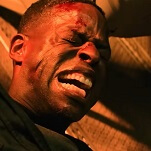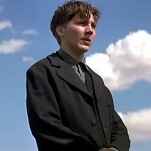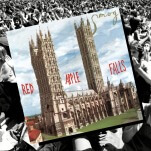In the 1997 comedy Wag The Dog, Dustin Hoffman plays Stanley Motss, a movie producer hired to distract from a presidential sex scandal by orchestrating a fake war in Albania. Toward the end of the film, as Motss watches the elaborate military funeral he helped put together, he laments that his efforts are destined to go unrewarded—and not just in this instance. “There is no Academy Award for producing. Where do movies come from if nobody produces them?” Producers, of course, do get an award. It’s called Best Picture.
Like many of the Academy Awards, Best Picture has undergone a number of changes, from the discontinuation of Unique And Artistic Picture (a prize handed out solely to F.W. Murnau’s Sunrise) to small name tweaks (varying combinations of “Best/Outstanding” and “Production/Picture,” give or take the “Motion” bit) to the recent announcement (and speedy retraction) of the Best Popular Film category. Also of note is that up until 1950, the award went to the production company, after which it was given to all credited producers. In the matter of film ownership, one simply had to follow the money. (Apparently leery, however, of handing out too many golden statuettes, the Academy imposed a limit of three recipients after Shakespeare In Love won for its five producers at the 1999 Oscars.)
What hasn’t changed is that the award isn’t typically seen as an achievement in producing, which is fair enough—that’s why the Producers Guild Awards exist. When voting for Best Picture, one can theoretically judge the film qua film, which is (presumably) why it’s the one category whose nominations are open to all voting members of the Academy, and not delegated to just the Producers Branch. But what if Best Picture was evaluated as an achievement in production? Perhaps this year’s Best Picture race would look a little different. Perhaps we’d be talking about The Other Side Of The Wind.
Frankly, it should be surprising that the film isn’t being talked about more. This is, after all, Orson Welles’ legendary final movie—what was supposed to be the director’s triumphant return to Hollywood after years spent in Europe. Shot on and off between 1970 and 1976, after which it got mired in financial and legal difficulties that prevented completion, Wind became a kind of Holy Grail for many, the subject of continual, obsessive speculation and at least one book: Orson Welles’s Last Movie, Josh Karp’s comprehensive, worthwhile account of the film’s tumultuous production. Starring in Wind as Jake Hannaford, a legendary director who returns to Hollywood to make a comeback film (sound familiar?), John Huston once described the project as “an adventure shared by desperate men that finally came to nothing.” But now, more than three decades after Welles’ death in 1985, it’s here—viewable through no less than Netflix, which put down the funding needed to get the film finished. Something finally came of that adventure—and it’s now possible to begin figuring out what it even is.
Right off the bat, it’s worth noting that Wind’s high virtues should, in my view, already merit serious awards consideration. In a different universe, one could imagine awards frontrunner status for cinematographer Gary Graver, who spent much of his life trying to get the film completed; editor Bob Murawski (The Hurt Locker), who had the unenviable task of figuring out what Welles would have wanted based on an unfinished work print; and legendary French composer Michel Legrand (The Umbrellas Of Cherbourg), who first collaborated with Welles on F For Fake in 1973. Another thing: This wouldn’t actually be my preference for how Best Picture should be viewed across the board, since it would likely end up elevating degree-of-difficulty over artistic merit—the production equivalent of lauding performances predicated on arduous physical transformations.
But if one were to engage in this thought experiment, there are few more ideal objects of study than Wind, a film whose appeal as a movie is maddeningly, gloriously inextricable from its singular production context. Much about the film’s history can be found in Morgan Neville’s Netflix-produced documentary They’ll Love Me When I’m Dead (on which the aforementioned Karp is a credited producer). And though the film too often indulges the kind of reductive artist psychologizing that Wind caustically rejects, it remains a useful primer on the endless funhouse distortions embedded in the project. “Is the camera a reflection of reality, or is reality a reflection of the camera eye? Or is the camera a phallus?” a pseudo-intellectual journalist asks Huston’s director character early on in Wind—a line that’s as indicative of Welles’ position on cheap biographical readings as it is of the film’s dizzying, self-reflective mise-en-abyme.
The actual (post-) production work carried out after Welles’ death in 1985, though, is readily distinguished from the legendary director’s original contributions. Without the efforts of credited producers Frank Marshall and Filip Jan Rymsza, the original film negatives might still be locked away in a French vault. (Only after a legal agreement was brokered between the three major parties with claims to Wind—Orson’s daughter, Beatrice Welles; the French production company Les Films de l’Astrophore; and Welles’ partner Oja Kodar, who cowrote and starred in the film—could the raw materials be transferred to Los Angeles, where much of the reconstruction work took place.) Though Marshall is now a storied Hollywood producer (his credits include Raiders Of The Lost Ark and Back To The Future), he first came on Wind as a novice production manager. “It was before I understood what a producer did,” he says on A Final Cut For Orson, a featurette released on Netflix alongside the finished film.
The 38-minute documentary isn’t much more than a solid extra, but for those interested in process, it’s a fascinating watch—an abridged but reasonably detailed rundown of the logistical maneuvers and artistic decisions required of both Marshall and Rymsza at each step of the reconstruction process. Guided by de facto blueprints of Welles’ vision—stray memos, notes, annotated scripts, and even sound dailies of his on-set direction—both men were involved in artistic choices major and minor, from hiring Legrand to finessing his score’s inclusion in specific scenes. (Though Rymsza came to the project relatively late, in May of 2009, he reportedly familiarized himself with Wind-related material stored in the Welles archive at the University Of Michigan.) Even the crucial matter of who to consult with occurred under their watch: Kodar provided notes on a rough cut, and Peter Bogdanovich (who appears in the film and promised Welles he’d complete it in his stead 40 years prior) offered essential support throughout. Which is all to say that while one could quibble with the choices overseen by both producers, their considerable impact on the film’s current, 122-minute form is undeniable.
It’s worth reiterating that, in most cases, evaluating an award on such extra-textual details would be ill-advised. The achievement of Best Picture is superlative precisely because, unlike the other Academy Award categories, it doesn’t require one to untangle individual artistic contributions from the larger work of art. Sussing out a director’s contributions already presents myriad difficulties; determining a producer’s precise input on any given project is arguably even more fraught, since modes of production vary widely from film to film, with individuals often taking on multi-hyphenate roles. (Of the 10 films nominated in the 2019 PGAs, for example, six have their respective directors credited as producers.)
But there is something to be said for recognizing feats of producing that aren’t so easily separated from the finished project—those rare, cherishable instances where the circumstances of production don’t constrain a film but actively enrich it. Take Richard Linklater’s Boyhood, a movie that’s nigh-impossible to view outside its singular context. Shot piecemeal over a staggering 12 years—an impressive logistical achievement in and of itself—the film effectively harnesses Jacques Rivette’s now-famous observation that every film is a documentary of its own making, and feeds that awareness back into the work. Along these lines, one might consider something like Mariano Llinás’ La Flor (produced by Laura Citarella and included in last year’s New York Film Festival), a behemoth 868-minute Argentinian film shot over nine years, starring the same four actresses. Though production is often seen as a task of securing funding, it certainly doesn’t preclude genuine artistic collaboration. After all, genius can’t exist in a vacuum.
On the whole, making a producer’s contributions the sole basis of Best Picture would still be misguided. But in those instances where they so naturally augment the experience of the film itself, why limit one’s assessment? The version of Wind that now exists may be incomplete in that it’ll never truly be the film that Welles would have put together; the choices made by Rymsza and Marshall are speculative—necessarily so. It’s not hard to imagine a different pair of producers (or even the same producers in another time or context) coming up with an appreciably different version of Wind. But there’s something apropos, even ideal about this irresolvable state. Though not mangled in the way that The Magnificent Ambersons was, the film still carries a sense of tantalizingly unrealized potential. Put together in this way, The Other Side Of The Wind feels a bit like a labyrinth of mirrors with no exit—and in doing the crucial restorative/reconstructive work, its producers have granted us entrance. That alone should merit some sort of award. Best Picture wouldn’t be a bad start.








































